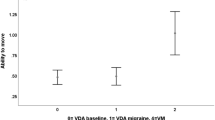Abstract
The purpose of this study was to estimate the general population lifetime and point prevalence of visual height intolerance and acrophobia, to define their clinical characteristics, and to determine their anxious and depressive comorbidities. A case–control study was conducted within a German population-based cross-sectional telephone survey. A representative sample of 2,012 individuals aged 14 and above was selected. Defined neurological conditions (migraine, Menière’s disease, motion sickness), symptom pattern, age of first manifestation, precipitating height stimuli, course of illness, psychosocial impairment, and comorbidity patterns (anxiety conditions, depressive disorders according to DSM-IV-TR) for vHI and acrophobia were assessed. The lifetime prevalence of vHI was 28.5 % (women 32.4 %, men 24.5 %). Initial attacks occurred predominantly (36 %) in the second decade. A rapid generalization to other height stimuli and a chronic course of illness with at least moderate impairment were observed. A total of 22.5 % of individuals with vHI experienced the intensity of panic attacks. The lifetime prevalence of acrophobia was 6.4 % (women 8.6 %, men 4.1 %), and point prevalence was 2.0 % (women 2.8 %; men 1.1 %). VHI and even more acrophobia were associated with high rates of comorbid anxious and depressive conditions. Migraine was both a significant predictor of later acrophobia and a significant consequence of previous acrophobia. VHI affects nearly a third of the general population; in more than 20 % of these persons, vHI occasionally develops into panic attacks and in 6.4 %, it escalates to acrophobia. Symptoms and degree of social impairment form a continuum of mild to seriously distressing conditions in susceptible subjects.


Similar content being viewed by others
References
Kessler RC, McGonagle KA, Zhao S, Nelson CB, Hughes M, Eshleman S, Wittchen HU, Kendler KS (1994) Lifetime and 12-month prevalence of DSM-III-R psychiatric disorders in the United States. Results from the National Comorbidity Survey. Arch Gen Psychiatry 51:8–19
Bijl RV, Ravelli A, van Zessen G (1998) Prevalence of psychiatric disorder in the general population: results of The Netherlands Mental Health Survey and Incidence Study (NEMESIS). Soc Psychiatry Psychiatr Epidemiol 33:587–595
Kessler RC, Chiu WT, Demler O, Merikangas KR, Walters EE (2005) Prevalence, severity, and comorbidity of 12-month DSM-IV disorders in the National Comorbidity Survey Replication. Arch Gen Psychiatry 62:617–627
Becker ES, Rinck M, Türke V, Kause P, Goodwin R, Neumer S, Margraf J (2007) Epidemiology of specific phobia subtypes: findings from the Dresden Mental Health Study. Eur Psychiatry 22:69–74
Stinson FS, Dawson DA, Patricia Chou S, Smith S, Goldstein RB, June Ruan W, Grant BF (2007) The epidemiology of DSM-IV specific phobia in the USA: results from the National Epidemiologic Survey on alcohol and related conditions. Psychol Med 37:1047–1059
Magee WJ, Eaton WW, Wittchen HU, McGonagle KA, Kessler RC (1996) Agoraphobia, simple phobia, and social phobia in the National Comorbidity Survey. Arch Gen Psychiatry 53:159–168
Wells JE, Browne MA, Scott KM, McGee MA, Baxter J (2006) Kokaua J; New Zealand Mental Health Survey Research Team. Prevalence, interference with life and severity of 12 month DSM-IV disorders in Te Rau Hinengaro: the New Zealand Mental Health Survey. Aust N Z J Psychiatry 40:845–854
Sareen J, Chartier M, Kjernisted KD, Stein MB (2001) Comorbidity of phobic disorders with alcoholism in a Canadian community sample. Can J Psychiatry 46:733–740
Scott KM, McGee MA, Oakley Browne MA, Wells JE (2006) New Zealand Mental Health Survey Research Team. Mental disorder comorbidity in Te Rau Hinengaro: the New Zealand Mental Health Survey. Aust N Z J Psychiatry 40:875–881
Emmelkamp PMG, Wittchen HU (2009) Specific phobias. In: Andrews G, Charney DS, Sirovatka PJ, Regier DA (eds) Stress-induced and fear circuitry disorders. American Psychiatric Association, Arlington, pp 77–101
LeBeau RT, Glenn D, Liao B, Wittchen HU, Beesdo-Baum K, Ollendick T, Craske MG (2010) Specific phobia: a review of DSM-IV specific phobia and preliminary recommendations for DSM-V. Depress Anxiety 27:148–167
Curtis GC, Magee WJ, Eaton WW, Wittchen HU, Kessler RC (1998) Specific fears and phobias Epidemiology Classification. Br J Psychiatry 173:212–217
Depla MF, ten Have ML, van Balkom AJ, de Graaf R (2008) Specific fears and phobias in the general population: results from the Netherlands Mental Health Survey and Incidence Study (NEMESIS). Soc Psychiatry Psychiatr Epidemiol 43:200–208
Oosterink FM, de Jongh A, Hoogstraten J (2009) Prevalence of dental fear and phobia relative to other fear and phobia subtypes. Eur J Oral Sci 117:135–143
Brandt T, Benson J, Huppert D (2012) What to call “non-phobic” fear of heights? Br J Psychiatry 190:81
Brandt T, Arnold F, Bles W, Kapteyn TS (1980) The mechanism of physiological height vertigo I. Theoretical approach. Acta Otolaryngol 89:513–523
Jacob RG, Redfern MS, Furman JM (2009) Space and motion discomfort and abnormal balance control in patients with anxiety disorders. J Neurol Neurosurg Psychiatry 80:74–78
Coehlo CM, Wallis G (2010) Deconstruction acrophobia: physiological and psychological precursors to developing a fear of heights. Depress Anxiety 27:864–870
Furman JM, Balaban CD, Jacob RG, Marcus DA (2005) Migraine-anxiety related dizziness (MARD): a new disorder? J Neurol Neurosurg Psychiatry 76:1–8
Huppert D, Grill E, Brandt T (2013) Down on heights? One in three has visual height intolerance. J Neurol 260:597–604
Häder S, Gabler S (1998) Ein neues Stichprobendesign für telefonische Umfragen in Deutschland. In: Gabler S, Häder S, Hoffmeyer-Zlotnik JHP (eds) Telefonstichproben in Deutschland. Westdeutscher Verlag, Opladen, pp 69–88
Kish L (1949) A procedure for objective respondent selection within the household. J Am Statist Assoc 44:380–387
Gibson EJ, Walk RD (1960) The “visual cliff”. Sci Am 202:64–71
Hiatt SW, Campos JJ, Emde RN (1979) Facial patterning and infant emotional expression: happiness, surprise, and fear. Child Dev 50:1020–1035
Walk RD, Gibson EJ (1961) A comparative and analytical study of visual depth perception. Psychol Monograph 75(15):1–44
Bles W, Kapteyn TS, Brandt T, Arnold F (1980) The mechanism of physiological height vertigo II. Posturography. Acta Otolaryngol 89:534–540
Bronstein AM, Buckwell D (1997) Automatic control of postural sway by visual motion parallax. Exp Brain Res 113:243–248
Redfern MS, Furman JM, Jacob RG (2007) Visually induced postural sway in anxiety disorders. J Anxiety Disord 21:704–716
Boffino CC (2009) Cardoso de Sá CS, Gorenstein C, Brown RG, Basile LFH, Ramos RT. Fear of heights: cognitive performance and postural control. Eur Arch Psychiatry Clin Neurosci 259:114–119
Alpers GW, Adolph D (2009) Exposure to heights in a theme park: fear, dizziness, and body sway. J Anxiety Disord 23:381–386
Clerkin EM, Cody MW, Stefanucci JK, Proffitt DR, Teachman BA (2009) Imagery and fear influencing height perception. J Anxiety Disord 23:381–386
Stefanucci JK, Storbeck J (2009) Don’t look down: emotional arousal elevates height perception. J Exp Psychol Gen 138:131–145
Teachman BA, Stefanucci JK, Clerkin EM, Cody MW, Proffitt DR (2007) A new mode of fear expression: perceptual bias in height fear. Emotion 8:296–301
Menzies RG, Clarke JC (1993) The etiology of fear of heights and its relationship to severity and individual response patterns. Behav Res Ther 31:355–365
Menzies RG, Clarke JC (1995) The etiology of phobias: a nonassociative account. Clin Psychol Rev 15:23–48
Poulton R, Davies S, Menzies RG, Langley JD, Silva PA (1998) Evidence for a non-associative model of the acquisition of a fear of heights. Behav Res Ther 36:537–544
Poulton R, Menzies RG (2002) Non-associative fear acquisition: a review of the evidence from retrospective and longitudinal research. Behav Res Ther 40:127–149
Berger M (2010) ‘It’s the sight not the bite’: a model and reinterpretation of visually-based developmental fears. Clin Psychol Rev 30:779–793
Hofmann SG, Alpers GW, Pauli P (2009) Phenomenology of panic and phobic disorders. In: Stein MB, Anthony MM (eds) Oxford Handbook of Anxiety and Related Disorders. Oxford Library of Psychology. Oxford University Press, Oxford, pp 36–46
Gamble AL, Harvey AG, Rapee RM (2010) Specific phobia. In: Stein DJ, Hollander E, Rothbaum BO (eds) Textbook of anxiety disorders, 2nd edn. American Psychiatric Publishing, Washington, London, pp 525–543
Menzies RG (1997) Height phobia, in Phobias. In: Davey GLC (ed) A handbook of theory, research and treatment. Wiley, Chichester, pp 129–138
Choy Y, Fyer AJ, Goodwin RD (2007) Specific phobia and comorbid depression: a closer look at the National Comorbidity Survey data. Compr Psychiatry 48:132–136
Huppert D, Grill E, Kapfhammer HP, Brandt T (2013) Susceptibility to visual height intolerance is independent of alcohol drinking patterns. Brain Behav 3:596–601
Grill E, Huppert D, Kapfhammer HP, Brandt T. Self-efficacy beliefs are associated with visual height intolerance: a cross-sectional survey. PLoS one (submitted)
Brandt T, Huppert D (2014) Fear of heights and visual height intolerance. Curr Opin Neurol 27:111–117
Balaban CD, Jacob RG, Furman JM (2011) Neurologic bases for comorbidity of balance disorders, anxiety disorders and migraine: neurotherapeutic implications. Expert Rev Neurother 11:379–394
Acknowledgments
H.P. Kapfhammer and W. Fitz had full access to all of the data in the study and take responsibility for the integrity of the data and the accuracy of the data analysis. All other authors contributed to literature search, study design, and discussion of the results. They also had full access to all the data in the study. The study was supported by the German Ministry of Education and Research (German center for vertigo and balance disorders, IFBLMU), and the Hertie Foundation. The authors thank Judy Benson for copyediting the manuscript.
Conflict of interest
None.
Author information
Authors and Affiliations
Corresponding author
Rights and permissions
About this article
Cite this article
Kapfhammer, HP., Huppert, D., Grill, E. et al. Visual height intolerance and acrophobia: clinical characteristics and comorbidity patterns. Eur Arch Psychiatry Clin Neurosci 265, 375–385 (2015). https://doi.org/10.1007/s00406-014-0548-y
Received:
Accepted:
Published:
Issue Date:
DOI: https://doi.org/10.1007/s00406-014-0548-y




